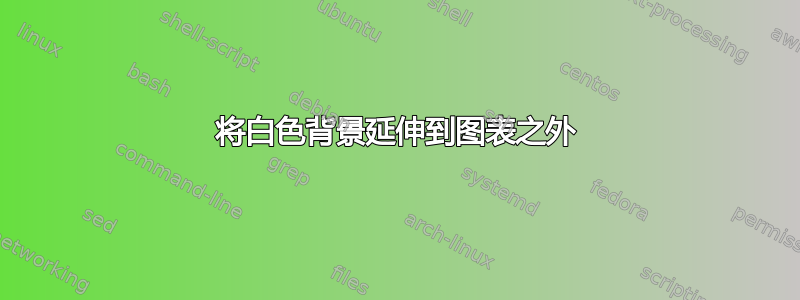
我想扩展白色背景,使其位于箭头下方。
*灰色矩形只是为了对比看看背景停止的位置。
我根据同一个模板生成了很多图表。因此,参数中包含此类信息非常重要。
我查看了 pgfplots 手册,但没有找到信息。有什么想法吗?使用 tikzset 而不是 pgfplotsset?
%%%%%%%%%%%%%%%%%% INTRODUCTION %%%%%%%%%%%%%%%%%%
\documentclass[border=10pt]{standalone}
%%%%%%%%%%%%%%%%%% INPUT %%%%%%%%%%%%%%%%%%
%\input{preamble.tex}
%\input{parameters.tex}
%%%%%%%%%%%%%%%%%% PACKAGE %%%%%%%%%%%%%%%%%%
\usepackage{tikz, tkz-euclide}% permet de dessiner des figures, des graphiques
\usepackage{pgfplots}
%\usepackage{adjustbox}% permet de déterminer une taille de fenêtre
%% FONT
\usepackage[utf8]{inputenc}
\usepackage[T1]{fontenc}
%
\usepackage{tgadventor}% paquet de police de caractère TGadventor
\usepackage{sansmath}% Copie-colle la police active dans
% \sfdefault (/!\ N'EST PAS UNE POLICE DE CARACTÈRES)
\usepackage{xcolor}
\usetikzlibrary{arrows.meta}
%%%
\tikzset{graphpgf/.style={font={\sansmath\sffamily\Large}, line cap=round, line join=round, >={Latex[length=3mm]}, x=1.0cm, y=1.0cm}}
%%% Paramètre graphique des graphiques orthonormés pgfplots
\pgfplotsset{/pgfplots/graphxy/.style={
%%%%%%%%%% Dimensionnement de l'image %%%%%%%%%%
width=15cm,
height=15cm,
unit vector ratio=1 1 1,
%%%%%%%%%% esthétique des axes %%%%%%%%%%
xlabel=$x$, ylabel=$y$,
axis lines = middle,
enlargelimits=false,
line width=0.4mm,
every major grid/.append style={black!20, line width=0.35mm,},
every minor grid/.append style={black!15, line width=0.15mm,},
every major tick/.append style={line width=0.4 mm, major tick length=7pt, black},
every minor tick/.append style={line width=0.15mm, minor tick length=4pt, black},
axis background/.style={fill=white,},
grid=both,
axis line style = {shorten >=-12.5pt, shorten <=-12.5pt, -{Latex[length=3mm]}},
xlabel style={at={(ticklabel* cs:1)},yshift=-3.5pt, anchor=north west, font=\sansmath\sffamily\Large},
ylabel style={at={(ticklabel* cs:1)},xshift=-3.5pt,, anchor=south east, font=\sansmath\sffamily\Large},
title style = {font=\sansmath\sffamily\Large, align=center, inner sep=12pt,},
}
}
%%%%%%%%%%%%%%%%%% DOCUMENT %%%%%%%%%%%%%%%%%%
\begin{document}
\begin{tikzpicture}[graphpgf,]
\draw[fill=black!50]
(-1,-1) rectangle (15,12)
;
%%%%%%%%%%%%%%%%%% Data Table %%%%%%%%%%%%%%%%%%
\begin{axis}[%
graphxy,
%%% Axe x
xmin=-5-0.5, xmax=5+0.5,
xtick={-15,...,15},
%minor xtick={-10,...,8},
%domain=-10:10,
%%% Axe x
ymin=-4-0.5,ymax=4+0.5,
ytick={-15,...,15},
%minor ytick={-8,...,8},
%minor tick num=1,
]%
\draw[]
(axis cs:0,0) coordinate node [circle, fill=black, draw=black, scale=.2, label={[inner sep=6pt, xshift=6pt]below:0}] {}
;
\draw[]
(axis cs:-4,1) coordinate node [circle, fill=black, scale=.5, label={[inner sep=6pt, xshift=6pt]above:A}] {}
(axis cs:-2,3) coordinate node [circle, fill=black, scale=.5, label={[inner sep=6pt, xshift=6pt]above:B}] {}
(axis cs:-1,2) coordinate node [circle, fill=black, scale=.5, label={[inner sep=6pt, xshift=6pt]above:C}] {}
(axis cs:3,3) coordinate node [circle, fill=black, scale=.5, label={[inner sep=6pt, xshift=6pt]above:D}] {}
(axis cs:4,1) coordinate node [circle, fill=black, scale=.5, label={[inner sep=6pt, xshift=6pt]above:E}] {}
(axis cs:1,-1) coordinate node [circle, fill=black, scale=.5, label={[inner sep=6pt, xshift=6pt]above:F}] {}
(axis cs:-3,-3) coordinate node [circle, fill=black, scale=.5, label={[inner sep=6pt, xshift=6pt]above:G}] {}
(axis cs:2,-2) coordinate node [circle, fill=black, scale=.5, label={[inner sep=6pt, xshift=6pt]above:H}] {}
;
\end{axis}
\end{tikzpicture}
\end{document}
答案1
像这样?
%%%%%%%%%%%%%%%%%% INTRODUCTION %%%%%%%%%%%%%%%%%%
\documentclass[border=10pt]{standalone}
%%%%%%%%%%%%%%%%%% INPUT %%%%%%%%%%%%%%%%%%
%\input{preamble.tex}
%\input{parameters.tex}
%%%%%%%%%%%%%%%%%% PACKAGE %%%%%%%%%%%%%%%%%%
\usepackage{tikz, tkz-euclide}% permet de dessiner des figures, des graphiques
\usepackage{pgfplots}
%\usepackage{adjustbox}% permet de déterminer une taille de fenêtre
%% FONT
\usepackage[utf8]{inputenc}
\usepackage[T1]{fontenc}
%
\usepackage{tgadventor}% paquet de police de caractère TGadventor
\usepackage{sansmath}% Copie-colle la police active dans
% \sfdefault (/!\ N'EST PAS UNE POLICE DE CARACTÈRES)
\usepackage{xcolor}
\usetikzlibrary{arrows.meta,backgrounds}
%%%
\tikzset{graphpgf/.style={font={\sansmath\sffamily\Large},
line cap=round, line join=round, >={Latex[length=3mm]}, x=1.0cm, y=1.0cm,
background rectangle/.style={draw,line width=1cm,black!50},
show background rectangle,inner frame sep=1cm}}
%%% Paramètre graphique des graphiques orthonormés pgfplots
\pgfplotsset{/pgfplots/graphxy/.style={
%%%%%%%%%% Dimensionnement de l'image %%%%%%%%%%
width=15cm,
height=15cm,
unit vector ratio=1 1 1,
%%%%%%%%%% esthétique des axes %%%%%%%%%%
xlabel=$x$, ylabel=$y$,
axis lines = middle,
enlargelimits=false,
line width=0.4mm,
every major grid/.append style={black!20, line width=0.35mm,},
every minor grid/.append style={black!15, line width=0.15mm,},
every major tick/.append style={line width=0.4 mm, major tick length=7pt, black},
every minor tick/.append style={line width=0.15mm, minor tick length=4pt, black},
%axis background/.style={fill=white,},
grid=both,
axis line style = {shorten >=-12.5pt, shorten <=-12.5pt, -{Latex[length=3mm]}},
xlabel style={at={(ticklabel* cs:1)},yshift=-3.5pt, anchor=north west, font=\sansmath\sffamily\Large},
ylabel style={at={(ticklabel* cs:1)},xshift=-3.5pt,, anchor=south east, font=\sansmath\sffamily\Large},
title style = {font=\sansmath\sffamily\Large, align=center, inner sep=12pt,},
}
}
%%%%%%%%%%%%%%%%%% DOCUMENT %%%%%%%%%%%%%%%%%%
\begin{document}
\begin{tikzpicture}[graphpgf]
%%%%%%%%%%%%%%%%%% Data Table %%%%%%%%%%%%%%%%%%
\begin{axis}[%
graphxy,
%%% Axe x
xmin=-5-0.5, xmax=5+0.5,
xtick={-15,...,15},
%minor xtick={-10,...,8},
%domain=-10:10,
%%% Axe x
ymin=-4-0.5,ymax=4+0.5,
ytick={-15,...,15},
%minor ytick={-8,...,8},
%minor tick num=1,
]%
\draw[]
(axis cs:0,0) coordinate node [circle, fill=black, draw=black, scale=.2, label={[inner sep=6pt, xshift=6pt]below:0}] {}
;
\draw[]
(axis cs:-4,1) coordinate node [circle, fill=black, scale=.5, label={[inner sep=6pt, xshift=6pt]above:A}] {}
(axis cs:-2,3) coordinate node [circle, fill=black, scale=.5, label={[inner sep=6pt, xshift=6pt]above:B}] {}
(axis cs:-1,2) coordinate node [circle, fill=black, scale=.5, label={[inner sep=6pt, xshift=6pt]above:C}] {}
(axis cs:3,3) coordinate node [circle, fill=black, scale=.5, label={[inner sep=6pt, xshift=6pt]above:D}] {}
(axis cs:4,1) coordinate node [circle, fill=black, scale=.5, label={[inner sep=6pt, xshift=6pt]above:E}] {}
(axis cs:1,-1) coordinate node [circle, fill=black, scale=.5, label={[inner sep=6pt, xshift=6pt]above:F}] {}
(axis cs:-3,-3) coordinate node [circle, fill=black, scale=.5, label={[inner sep=6pt, xshift=6pt]above:G}] {}
(axis cs:2,-2) coordinate node [circle, fill=black, scale=.5, label={[inner sep=6pt, xshift=6pt]above:H}] {}
;
\end{axis}
\end{tikzpicture}
\end{document}





